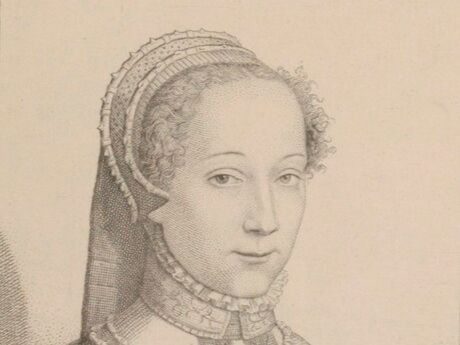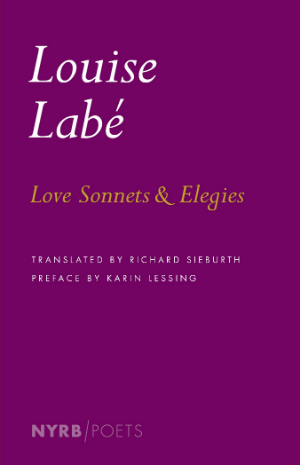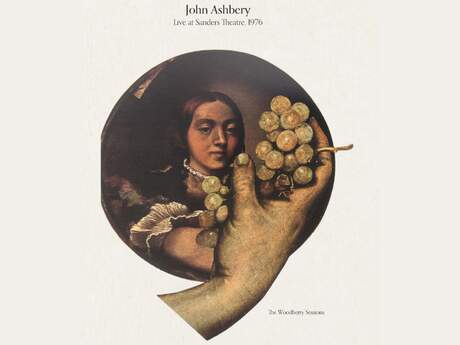Tributes
Louise Labé: A conversation with translator Richard Sieburth and editor Jeffrey Yang

Each edition of Richard Sieburth's astonishing translations of French and German literature has resituated and recreated the original work into a lasting book of English prose and verse—Friedrich Hölderlin's late Hymns and Fragments, Gérard de Nerval's Selected Writings and his novel The Salt Smugglers (a publication that even echoes the typographical layout of its original left-wing feuilleton newspaper publication), Nostradamus's Prophecies, the Délie of Maurice Scève, among many others. In the same spirit of reinvention, Sieburth's new edition of French Renaissance poet Louise Labé was just published by NYRB/Poets. Jeffrey Yang, who was the in-house editor for the book, as well as for Sieburth's edited volume of Ezra Pound's New Selected Poems and Translations, talks with the master translator about Louise Labé.
* * *
Jeffrey Yang: How would you describe the work of Louis Labé to readers who know nothing about her?
Richard Sieburth: Louise Labé is, by general consensus, the finest French woman poet of the Renaissance. She was not the only woman to have published poetry in sixteenth-century France—Marguerite de Navarre and Pernette du Guillet also come to mind—but unlike these latter two, Labé was not a member of the nobility or the upper classes, but the daughter of a prosperous ropemaker in Lyon. The Lyon context is very important: if Paris is the administrative and royal capital of France, Lyon is its most economically dynamic city. Situated at the confluence of the Rhône and Saône rivers, linked by trade routes to the rest of Europe, Lyon is the center of a (Florentine-dominated) banking industry which enables the circulation of capital and labor into the local production of textiles and books, both of which are woven and textured things—as is, of course, rope, made of hemp (Rabelais' magical Pantegruelion plant) which, in the form of cordage, is to the Renaissance what steel is to the industrial revolution. Without rope, no conveyance, no commerce, no sailing ships, no exploration, no translation. Labé was known as "La Belle Cordière"—The Fair Ropemaker. She is an artisan of twining. This is what I above all wanted to articulate in my English versions: the rhythmic inter-knotting of her lines, their rhymed cordage as taut and tensile as rope.
As a member of the lower orders—and as a woman—Labé is closer to vernacular French than the male literati of Lyon, that is, that school of humanist writers gathered around the poet Mauric Scève who compose texts just as easily in French as in neo-Latin (or Italian). Labé vernacularizes French verse—that is, she de-Latinizes it, while stripping it of much of its erudite baggage of classical mythological allusion (or, for that matter, Christian allegory). An intensely secular sensibility, she moves poetry closer to the drive of speech, as it crosses over into song. But she has to do this within the inherited conventions of a lyric tradition essentially invented by men. The single notable exception to this tradition of male love poetry would be Sappho, still only dimly known in the mid-sixteenth century, but nonetheless the model to whom Labé turns to in order to fashion a female voice. So this was the other thing (along with the formal cordage of her verse) that I wanted to bring out in my English versions: Labé's discovery of a poetic space in which it becomes possible for a woman to write as the intense subject, and not merely the largely imaginary object, of desire.
This lyric space had already been opened in the Renaissance by several notable Italian women poets—Vittoria Colonna, Tulia d'Aragona, Gaspara Stampa—but in the Lyon of Louise Labé this emergence of voice takes more explicitly proto-feminist turn (as witnessed by the epistolary preface, almost a manifesto for écriture féminine, that introduces her Works, which I have included in my edition). This is in part what drew Rilke to her poetry: he first writes about her in his Notebooks of Malte Laurids Brigge and then goes on publish his translations of her sonnets in 1917. Rilke's Umdichtungen—and their complex cross-genderings—are what first got me really interested in this project: we could talk about that more.
Jeffrey Yang: As a translator, as well as a scholar, teacher, and essayist, actively working since the late seventies, what drew you to her poetry at this moment in your life?
Richard Sieburth: I see my Labé as part of a larger Lyon triptych that I have been working on over the past number of years. It started out with my selections from Maurice Scève's Délie (1544), and then continued with my translation of the complete Prophecies of Nostradamus, which were published in Lyon in 1555, the very same year as Labé's Works.
I realize, looking back over my career as a translator, that it's not just been about inhabiting other identities or languages but, more vitally, about dwelling in other places: Hölderlin's Swabia, Benjamin's Moscow, Scholem's Jerusalem, Büchner's Strasbourg, Nerval's Valois, Baudelaire's Brussels—to name a few. With Scève, Labé, and Nostradamus I've been living in the Renaissance vortex of Lyon, at the meeting of rivers. Translation for me is deeply related to cartography. If I have managed, over the last thirty-five years, to put a few unsuspected voices and places on the map for contemporary English-speaking readers—if I have laid down a few roads for others to travel—I feel I will have succeeded in my task as a translator.
Jeffrey Yang: There's a number of fascinating cords you bring up which we can follow here! What you say of Labé reminds me of the Song Dynasty poet Li Qingzhao, or Sor Juana Inés de la Cruz writing a hundred years later, even her letter to Sor Filotea, often pointed to as one of the first feminist tracts, has its precursor in Labé's "Dedicatory Epistle" that you include in the front of the book, after your masterful chronology of her life. And then the cross-gendering issues you bring up that Labé picks up in her poems, which I want to come back to in a minute, but first, I was hoping you might talk a little bit more about some of the concrete ways you tackled Labé's "inter-knotted lines," the first sonnet of the twenty-four poem cycle she even composed in Italian!
Richard Sieburth: Among my models, as mentioned, was Rilke—a master of the sonnet and the elegy. But the more closely I studied Rilke's versions of Labé, the more I felt he was over-translating her. George Steiner talks about this in After Babel, noting that Rilke tends to "aggrandize" the originals by setting them into a "more solemn register," imparting to them something grandiosely baroque that tends to ruin the "ordinariness" and "small magic" of her language. Rilke, I would add, also turns Labé into a kind of sacred martyr of Love, spiritualizing (and Christianizing) her unrequited passion into a form of transcendence-through-suffering which opens out into the mystical realm of the Unbounded. I hear Labé as a figure far more ironic, far more caustic, far more tautly self-aware. Rilke unbinds Labé at the very level of her line, which (in her sonnets, at least) is fairly rigorously end-stopped, but which he often enjambs. Instead of observing Labé's tightly knotted lineations, he loosely drapes his sonnets over the more sinewy body of the originals, creating a fluidity (and a kind of hazy veiling) that detracts from her nakedness of utterance.
I'll give just one example—from her most famous sonnet, the one that erupts with the force of Donne's "Batter my heart, three-person'd God":
Baise m'encor, rebaise moy & baise:
A clean decasyllable, metrically divided into syllabic groups of 4 + 6 (or 4 + 4 + 2), and which, when I first came upon it as a teenager in a boarding school in Switzerland, struck me as an astonishing invitation on the part of woman (not to mention a sixteenth-century woman) to literally "Fuck me again, refuck me & fuck." Whereas of course in the Renaissance the intransitive verb "baiser" merely means "to kiss" (behind the poem lies Catullus's celebrated "Carmina V" addressed to Lesbia, "da mi basia mille"—"give me a thousand kisses"). At any rate, this is how Rilke handles the opening line:
Küss mich noch einmal, küss mich wieder, küsse
Mich ohne Ende
Annie Finch does something similar in her English translation:
Kiss me again, rekiss me, and then kiss
me again
These are perfectly reasonable solutions (and enjambment makes rhyming much easier)— except that I wanted to remain within the strict boundaries of Labé's line, which forms a dense prosodic, syntactic, and semantic unit. In this case, I decided to read Labé's line right to left: this produces a reverse mirror effect in translation, with everything packed into a single punch which ends, like the original, with a colon:
Kiss me, rekiss me, & kiss me again:
Give me one of your most delicious kisses,
A kiss in excess of all my fondest wishes:
I'll repay you four, more scalding than you spend.
In his song "Green Eyes," Nick Cave isolates this first line and renders it quite literally as "Kiss me again, rekiss me and kiss"—which also works wonderfully. But, as a translator I'm not just translating individual lines, but trying to articulate the overall formal patternings of her sonnets.
Jeffrey Yang: How did you approach her particular formalistic vernacular in trying to capture, as the poet Karin Lessing describes it in the preface to this edition, Labé's "perfect sharply defined architecture"? Were there models besides Scève you had in mind, other poets, or previous translations of Labé?
Richard Sieburth: As mentioned, the basic building block of Labé's sonnets is the single end-stopped line. The second building block is the rhymed epigrammatic couplet—which, following the practice of her master, Clément Marot, she inserts at the sonnet's volta, or "turn," at lines 9 and 10. In this same Catullan kiss-sonnet, this gives us the following tercets:
Then a double life to each shall ensue.
Each shall live, you in I & I in you.
Love, something crazy comes to mind:
I can't bear living on my best behavior,
And there's no joy I could truly savor
Unless aroused to leave myself behind.
The rhyme scheme here is CCD/EED. The sonnet pivots at line 10 with the CC couplet, and then moves into envelope rhyme (DEED), which recalls that of the initial quatrains (ABBA).
I think Labé is unique among the major sonneteers of her period (for example Ronsard or Du Bellay) in the way in which she handles her sestets. Her opening octaves are often fairly conventional, but in the closing tercets she engages in various sorts of logical and emotional syncopations, defined by colons and commas, which play the line against strophe and rhyme scheme, creating a lovely kind of stutter step. Here is a sestet (worthy of Bonnie Raitt) in CCD/EDE:
But promise, Friend, that when we meet again,
Love shall no longer prove to be our bane:
Let the encounter be not hard on me,
Treat me kindly: be ever so gentle,
Remind me again of all your beauty,
Once so cruel to me, now so simple.
Here's another in CCD/EED:
Thus you, my eyes, have taken much delight
In being the lucky objects of his sight:
But you, my heart, seeing my eyes' pleasure,
The more you envy, the more you despair:
Let none believe that I'm ease, aware
My heart & eyes are out of measure.
Here (the exception proving the rule) I enjamb the last two lines, and try to pick up a (Petrarchan) echo of Shakespeare's Sonnet 46: "Mine eye and heart are at mortal war." But in general, the idea was to avoid Shakespeare as much as possible, and to look toward pre-Elizabethan English—in particular, the sonnets of Wyatt (which first appeared one year after Labé's were published). Wyatt was also a very strong presence behind my versions of Scève—who, however, was not much interested in the emerging sonnet form, preferring instead to remain with the older French tradition of the dizain (a ten-line poem in decasyllables). Valéry Larbaud quipped that to read Scève's dizains against Ronsard's sonnets was to realize that Ronsard always went on for four lines too many. In a sense, Scève's dizains can be read as "curtal" sonnets (Hopkins's term), sonnets by subtraction. I wanted to get the same kind of Poundian Dichten=Condensare effect with Labé, using a four-stress English decasyllable line that subtracts a beat from the pentameter, while at the same time stripping down her sonnets to their bare architectonic bones by highlighting the role of the rhymed distich—which is also the basic unit of her Elegies. As Bernadette Mayer (whose sonnets were another model) writes: "Couplet I adore you it's my habit."
But perhaps this is all too technical....
Jeffrey Yang: Technical, yes, but I think it's fascinating and significant for readers to see some of the detailed thought and sweat behind these translations, the care involved that makes the result seem so effortless and free: And all the art that improves on Nature, / Could not increase the drive of my desire. And the "kiss me" Sonnet 18 you talk about is one of my favorites, Labé in her most playful mood. Overall, though, the love she writes about and elegizes and warns of to the audience she directly addresses, the "Ladies of Lyon," is cruel and fierce and unfair—much like the recent scholarship you tackle head on in your afterword that questions Labé's authorship of these poems. We don't have the space to get into this rollicking story here, suffice it to say that you argue persuasively and definitively for Labé as sole, singular author, but there's a remarkable point in her third elegy where Labé discards the traditional women's art of needlecraft for the traditional male world of books and martial arts as a ruse to trick and flee Love. That by switching genders, she can escape (or more fully confront?) her loss. Seeing this in relation to what Labé writes in her "Epistle," that "women do not willingly appear in public alone," what exactly is Labé doing here, "outing" herself as a poet who not only loves but suffers from love in a male-run world?
Richard Sieburth: Yes, in a way. You're alluding to the book that was published a few years ago in France by Mireille Huchon, a very well-respected specialist in Renaissance literature at the Sorbonne. Huchon claims that "Louise Labé Lionnoize" (as her name appears on the cover of her Works in 1555) was a literary hoax concocted by a coterie of poets gathered around Maurice Scève and his publisher in Lyon: she asks us to imagine a group of extremely literate Renaissance humanists all writing in drag in order to produce an imaginary local rockstar-poet who would honor the city (say, a Patti Smith New-Yorkaise). The book made quite a splash in France, and at least one prominent member of the Académie Française took it upon himself to expel her from the canon in the pages Le Monde: "Exit Louise Labé!" This caused quite an explosion, given that Labé is generally considered, in a French literary tradition that features relatively few major woman poets, to be one of the finest writers of the sixteenth century—not to mention her street cred (especially in US academia) as an Early Modern feminist. Now that the dust has settled, most scholars have dismissed as unfounded Huchon's claims that Labé was just a huge practical joke (on whom???). But at least her book opens up the possibility of a queer reading of Labé's work.
As you mention, in one of her elegies (written when she was around thirty), she speaks of her younger teenage self as "besotted with Mars and books"—portraying herself as a kind of tomboy who far preferred the arts of war (notably horsemanship and jousting) and the study of letters to anything as girlish as falling heads over heels in love. This dovetails with the legend of Labé in her lifetime as a kind of androgyne, who was all the more admirably "male" because of her frank (and apparently generous) sexuality—which caused puritans such as John Calvin to condemn her as an outright whore (though she was probably more of a cortegiana honesta or "honest courtesan" in the Italian sense of the term). At any rate, to return to this same elegy of hers, it was the warrior god Eros (so she claims) who turned her into a woman: having pierced her armor with his dart when she was not yet sixteen, he determined he would take her as his captive, reducing her to a slave of Love for the remainder of her life. Yet although Love has "estranged" her (one of her favorite words) into a helpless and emasculated victim of the cosmic force of Eros, her poetry is often written from the male point of view: this is, after all (with the exception of Sappho, whom she gets via Ovid's Heroides), the only discourse of love poetry available to her—be it Roman or Petrarchan—a discourse that dictates the very conventions of lyric or elegiac utterance within which she has to somehow invent herself as a (new, female) subject of desire.
This creates all sorts of gender-bending possibilities for her translator—let alone her male translator. If I were to follow Huchon's hypothesis to the letter, I would have to conceive of myself as a man translating a group of sixteenth-century Frenchmen cross-dressing as a female poet in order to compete with the Italians. In this case, I would merely be part of a larger homosocial circle jerk centered around the fantasy of a non-existent (and "Sapphic") muse. On the other hand, if one is to take Labé seriously as a "real" woman (as I do) and as the single author of her poems, one nonetheless has to attend to the fact that she is also very much writing as a (displaced, castrated) male within a mainline Western tradition of love lyrics. Either way, you end up in an androgynous—and therefore profoundly "bi" or "trans"—space of translation. This is where a newly queered Rilke (such as Uli Baer has just given us in his Rilke Alphabet) would again come into play.
Jeffrey Yang: In one sentence, what would you say is Labé's definition of Love?
Richard Sieburth: A mirror of misrecognition. Which, I suppose, also nicely defines translation—or, more specifically, transference—from a Lacanian point of view.
Jeffrey Yang: Is there any evidence that Shakespeare read Labé? They certainly share a Renaissance humanist-secular-individualist outlook, especially Labé: gods, mostly, and not God; Zephyr, Venus, and Diana but not Christ.
Richard Sieburth: Shakespeare might have encountered Labé through her sprightly philosophical work, The Debate Between Follie and Love, which was translated into English by Robert Greene in 1584. Greene, a raffish and very widely-read author of the day, is known to Shakespeare scholars for his posthumous pamphlet A Groatsworth of Wit Bought with a Million of Repentence (1592), which refers to a young actor by the name of "Shake-scene" and alludes to a line from Henry VI, part 3: "O tiger's heart wrapped in a woman's hide." Which nicely leads back to Labé….
Jeffrey Yang: Did Labé read Dante's Vita nuova?
Richard Sieburth: Her publisher, Jean de Tournes, had brought out an edition of Dante in the original in Lyon—so he was certainly in the air. But when it came to the modern philosophy of love, she was probably far more influenced by Leone Ebreo's Dialogues of Love, which she could have read either in the Italian original or in its recent French translation. Now better known as Judah Leon Abravanel, he was a Portuguese-born Sephardic student of the Cabbala who mixed with the neo-Platonists of Naples. A fascinating figure, much in vogue in Lyon at the time, later translated into Spanish by the Incan prince, Garcilaso de la Vega. Ah, the Renaissance. . .



